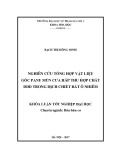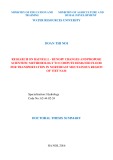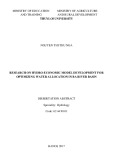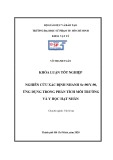
MINISTRY OF EDUCATION
AND TRAINING
MINISTRY OF AGRICULTURE
AND RURAL DEVELOPMENT
WATER RESOURCES UNIVERSITY
KHUONG THI HAI YEN
STUDYING THE CAPABILITY OF GREYWATER
TREATMENT ON SITE
BY USING LATERITE MATERIAL
Major:
Water resources engineering
Code:
62580212
DOCTORAL THESIS ABSTRACT
HANOI, 2016

The research is completed in Water Resources University, Hanoi, Vietnam
Advisor 1: Assoc. Prof., Dr. PHAM Thi Minh Thu
Advisor 2: Assoc. Prof., Dr. NGUYEN Thi Kim Cuc
Reviewer 1: Dr. TRINH Xuan Lai, Vietnam Water Suply and Sewerage Association
Reviewer 2: Assoc. Prof., Dr. NGUYEN Ngoc Dung, Ministry of Construction
Reviewer 3: Prof., Dr. TRAN Huu Uyen, Expert of Water Treatment
The doctoral thesis has been presented at Water Resources University,
Hanoi, Vietnam
At 8.30 on 30 th October 2016
Finding the doctoral thesis in:
- National Library
- Library of Water Resources University

1
INTRODUCTION
1. Urgency of research:
Greywater accounts for 69%1 of domestic wastewater flow and contaminant
concentrations lower than the blackwater but most of the pollution parameters
are not meet up the Regulation to discharge directly into the environment.
Wastewater treatment technology such as SBR, A2O only effective in treatment
of organic matter but not effective in treatment of nitrogen to reach the require
level; and often apply to big wastewater treatment plants. Need to research a
suitable processing solution with the scale and characteristics of greywater as
the criteria for: simple operation, high nitrogen removal efficiency, area of land
occupied is less and towards sustainable technologies.
Laterite is local materials, available in many areas in Vietnam country. Laterite
is form structure, contains many kinds of minerals such as clay (kaolinite,
bentonite), the hydroxides of iron, the hydroxides aluminum, zeolite, brucite,
gibbsite, goethite2 ... are substances that the polarity inside the water, with the
ability to exchange ions, in the crystal structure, manies void and large specific
surface area. Therefore the laterite is easy to join the adsorption, ion exchange,
electrostatically with some pollution matter and having the potential of
wastewater treatment field. However, these ability is reduced with time,
together with the clog process because the developed of microbial membranes.
This problem can improve with using laterite according multilayer soil layering
engineering3.
Thesis "Studying the capability of greywater treatment on site by using laterite
material" was conducted to determine the ability to treat the greywater of
laterite with multilayer layering engineering. The success of the studing is
opened up a new direction in the use of local materials, environmentally
friendly to treat greywater on-site; contribute to reduce pressure on the
1 Barnes, D và cộng sự, Water and Wastewater Engineering Systems, Pitman Books Ltd., ed. London, 1981.
2 Nyle C.Brandy, The nature and the Properties of soils, 2nd ed.: ISBN: 9780130167637, 2001.
3 T.Masunaga et al, "Characteristics of wastewater treatment using a Multi Soil Layering system in relation to wastewater
contamination level and hydrolic loading rates," Soil Science and Plant Nutrition, pp. 123-125, 2007.

2
wastewater treatment plants, the length of urban pipelines and environmental
pollution. The treated of greywater can be used for irrigation, control the
distribution domestic buildings and saving water resources for the future.
1.1 The aim of research
Determination of greywater characteristics from some buildings in Hanoi city;
Explaination of the principle of removing the main pollutants out of greywater
by using laterite with multi soil layering engineering; Determination of
decomposition rate coefficients of BOD5, COD and NH4
+ -N. The number of
laterite layer is calculated based on these coefficients; Successful greywater
treatment from building by using laterite with Multi Soil Layering engineering
and the treated effluent meet up the National Regulations (QCVN
14:2008/BTNMT; QCVN 08-MT:2015/BTNMT).
1.2 Object and scope of research
1.2.1 Object of research
Multi Soil Layering engineering is using laterite as main material for greywater
treatment from buliding in Ha noi city.
1.2.2 Scope of research
Greywater from some buildings in Hanoi city; Multi Soil Layering engineering
with natural laterite and heat denaturation laterite.
1.3 Method of research
Using main method of research such as: investigation and sample collection,
inheritance, lab analysis, lab model, pilot model, statistical method.
1.4 Content of research
Determination of greywater characteristics from some buildings in Hanoi city;
Studying the capacibilityof greywater treatment through lab Multi Soil
Layering models; Application the lab result for designing the pilot (MSL6-PL)
for greywater treatment onsite from B5-Yen Thuong building.
1.5 The scientific and practical significances

3
1.5.1 Scientific significances
- Determination of decomposition rate coefficients of BOD5, NH4
+ -N and
COD. The number of laterite layer is calculated based on these coefficients.
- Determination of efficiency, explaination of the principle of removing the
main pollutants out of greywater by using laterite with multi soil layering
engineering;
1.5.2 Practical significances
Applying for greywater treatment from buildings in Hanoi city. The quality of
effluent meet up the National Regulation QCVN 14:2008/BTNMT; QCVN
08:2008/BTNMT.
1.6 The structure of the thesis
The structure of the thesis beyond the preamble; conclusions and
recommendations; lists of articles were published; reference section; annexes;
Thesis is presented in threes chapters, including:
Chapter 1. Overview of the research problems
Chapter 2. Basic of scientific, material and studying method for greywater
treatment by using laterite with Multi Soil Layering Engineering.
Chapter 3. The research results of greywater treatment on-site by using laterite
with Multil Soil Layering engineering.
CHAPTER 1 : OVERVIEW OF THE RESEARCH PROBLEMS
1.1 Greywater
Greywater is part of the waste water without treatment and collected from
showers, lavabol, tub, kitchen sink… (except toilet and urine sink) and
accounted for 69% of domestic wastewater. The pollution concentrations of
organics and nutiens such as BOD5, COD, N, P are lower than the
concentration of black wastewater. The pollution concentrations in greywater
depends on habit and level of living, traditional, economic conditions,
management, methods of greywater collection and source of drainage etc each
area.














![Ô nhiễm môi trường không khí: Bài tiểu luận [Nổi bật/Chi tiết/Phân tích]](https://cdn.tailieu.vn/images/document/thumbnail/2025/20251011/kimphuong1001/135x160/76241760173495.jpg)







![Ứng dụng kỹ thuật trao đổi ion trong điện phân: Bài tiểu luận [chuẩn nhất]](https://cdn.tailieu.vn/images/document/thumbnail/2025/20250829/sonphamxuan1808/135x160/97341756442892.jpg)



